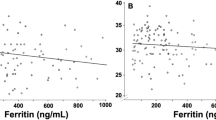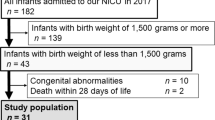Abstract
Objective: To study the effect of infection on iron status in children suffering from acute, mild or severe respiratory infections and to determine the nature of anemia in infection using serum transferrin receptor (sTfR) levels.
Design: Forty-three children aged between 3 and 5 y with no evidence of infection and receiving iron supplements in the preceding 100 days served as controls. Twenty-one children with mild upper respiratory infection and 94 children hospitalized for acute pneumonia constituted the experimental group. Hemoglobin (Hb), sTfR and serum ferritin were estimated in all the children at the time of diagnosis and again on the 15th and 30th days after the infection in those who were available for follow-up.
Results: Mean (95% CI) sTfR was 6.08 (5.1–7.1) mg/l in healthy non-anemic children. Upper respiratory infection had no impact on Hb or sTfR but it significantly elevated serum ferritin levels. Eighty-three percent of the children with pneumonia had Hb less than 110 g/l at the time of diagnosis and had elevated mean sTfR, 18.0 (15.7–20.3) mg/l. There was a decline in mean sTfR by the 15th day of infection to 14.3 (11.3–17.4) mg/l with further rise to 22.9 (13.0–31.9) mg/l by 30 days. Serum ferritin was significantly elevated at the time of diagnosis (85.9; 71.1–100.8 µg/l) as well as at 15 days (89.1; 68–110.1 µg/l) with a decline by 30 days.
Conclusion: Severe lower respiratory infection exaggerates iron-deficient erythropoiesis by blocking release of iron from the storage pools. sTfR may not be a sensitive and specific tool of assessing true iron status of children exposed to severe infections.
Sponsorship: Funding from the Department of Science and Technology (DST no. SP/SO/B-29/96), Government of India, New Delhi, India.
This is a preview of subscription content, access via your institution
Access options
Subscribe to this journal
Receive 12 print issues and online access
$259.00 per year
only $21.58 per issue
Buy this article
- Purchase on Springer Link
- Instant access to full article PDF
Prices may be subject to local taxes which are calculated during checkout



Similar content being viewed by others
References
Adelekan, DA & Thurnham, DI (1990). Plasma ferritin concentration in anemic children: relative importance of malaria, riboflavin deficiency and other infections. Am. J. Clin. Nutr., 51, 453–456.
Akenami, FOT, Vaheri, A, Koskiniemi, M, Kivi Vuori, S, Ekanem, EE, Bolarin, DM & Smiles, MA (1997). Severe malnutrition is associated with decreased levels of plasma transferrin receptor. Br. J. Nutr., 77, 391–397.
Basta, S & Churchill, A (1974). Iron deficiency anemia and the productivity of adult males in Indonesia, pp1–49, World Bank Staff working paper 175 Washington, DC: World Bank
Beisel, WR (1976). Trace elements in infectious processes. Med. Clin. N. Am., 60, 831–849.
Beisel, WR, Pekarek, RS & Wannemacher, RW Jr (1974). The impact of infectious disease on trace element metabolism in the host. In:Trace element metabolism in animals-2, ed. WG Hoekstra, JW Suttie, HE Ganther & W Mertz, pp217–240, Baltimore, MD: University Park Press
Beresford, CH, Neale, RJ & Brooks, OG (1971). Iron absorption and pyrexia. Lancet, 1, 568–572.
Bhaskaram, P (1988). Immunology of iron deficient subjects. In:Contemporary issues in Clinical Nutrition, Nutrition and Immunology, ed. RK Chandra, Vol II, pp149–164, New York: Liss
Bhaskaram, P (2001). Immunology of mild-moderate micronutrient deficiency. Br. J. Nutr., 85, (Suppl) S75–S80.
Cartwright, GE & Lee, GR (1971). The anemia of chronic disorders. Br. J. Haematol., 21, 147–152.
Chandra, RK & Grace, A (1985). Goldsmith award lecture. Trace element regulation of immunity and infection. J. Am. Coll. Nutr., 4, 5–16.
Dimitriou, H, Stiakaki, E, Markaki, EA, Bolonaki, I, Giannakopoulou, C & Kalmanti, M (2000). Soluble transferrin receptor levels and soluble transferrin receptor/log ferritin index in the evaluation of erythropoletic status in childhood infections and malignancy. Acta Paediatr, 89, 1169–1173.
Ferguson, BJ, Skikne, BS, Simpson, KM, Baynes, RD & Cook, JD (1992). Serum transferrin receptor distinguishes the anemia of chronic disease from iron deficiency anemia. J. Lab. Clin. Med., 119, 385–390.
Flowers, CH, Skikne, BS, Covell, AM & Cook, JD (1989). The clinical measurement of serum transferrin receptror. J. Lab. Clin. Med., 114, 368–377.
Heilmeyer, L & Wohler, F (1961). Iron uptake in inflammed tissues. Geriat. Med., 6, 313–316.
Kohgo, Y, Nishisato, T, Kondo, H, Tsushima, N, Niitsu, Y & Urushizaki, I (1986). Circulating transferrin receptor in human serum. Br. J. Haematol., 64, 277–281.
Kohgo, Y, Niitsu, Y, Nishisato, T, Kato, J, Kondo, H, Sasaki, K & Urushizaki, I (1988). Quantitation and characterization of serum transferrin receptor in-patients with anemias and polycythemias. Jpn. J. Med., 27, 64–70.
Konijn, AM & Hershko, C (1977). Ferritin synthesis in inflammation. I. Pathogenesis of impaired iron release. Br. J. Haematol., 37, 7–16.
Konijn, AM, Carmel, N, Levy, R & Hershko, C (1981). Ferritin synthesis in inflammation: mechanism of increased ferritin synthesis. Br. J. of Haematol., 49, 361–370.
Kuvibidila, S, Mark, JA, Warner, RP, Yu, L, Ode, D & Tshefu, KA (1995). Soluble transferrin receptor as an index of iron status in Zairian children with malaria. J. Trop. Med. Hyg., 98, 373–378.
Kuvibidila, S, Warner, RP, Ode, D, Yu, L & Tshefu, KA (1999). Lack of differences in iron status assessed by soluble transferrin receptor between children with cerebral malaria and those with non-cerebral malaria. J. Trop. Paediatr., 45, 166–167.
Lee, GR (1983). The anemia of chronic disease. Clin. Hematol., 20, 61–80.
Pawashe, AB, Raman, L, Nair, KM & Sarma, MKJ (1987). Validity of using capillary blood for the measurement of plasma ferritin. Clin. Chim. Acta, 163, 119–120.
Skikne, BS, Flowers, CH & Cook, JD (1990). Serum transferrin receptor: a quantitative measure of tissue iron deficiency. Blood, 75, 1870–1876.
Suominen, P, Mottonen, T, Rajamaki, A & Irjala, K (2000). Single values of serum transferrin receptor and transferrin receptor ferritin index can be used to detect true and functional iron deficiency in rheumatoid arthritis patients with anemia. Arthritis Rheum., 43, 1016–1020.
Walter, T, Olivares, M, Pizarro, F & Munoz, C (1997). Iron, anemia and infection. Nutr. Rev., 55, 111–124.
Weinberg, ED (1978). Iron and infection. Microbiol. Rev., 42, 45–46.
Zahringer, J, Baliga, BS & Munro, HN (1976). Novel mechanisms for translational control in regulation of ferritin synthesis by iron. Proc. Natl Acad. Sci. USA, 73, 857–861.
Acknowledgements
We thank Dr Kamala Krishnaswamy, Director, National Institute of Nutrition, for her keen interest in the study and Mr EP Ramachandran for his skillful technical assistance.
Author information
Authors and Affiliations
Corresponding author
Rights and permissions
About this article
Cite this article
Bhaskaram, P., Madhavan Nair, K., Balakrishna, N. et al. Serum transferrin receptor in children with respiratory infections. Eur J Clin Nutr 57, 75–80 (2003). https://doi.org/10.1038/sj.ejcn.1601496
Received:
Revised:
Accepted:
Published:
Issue Date:
DOI: https://doi.org/10.1038/sj.ejcn.1601496
Keywords
This article is cited by
-
Hemoglobin level as a risk factor for lower respiratory tract infections
The Indian Journal of Pediatrics (2006)



